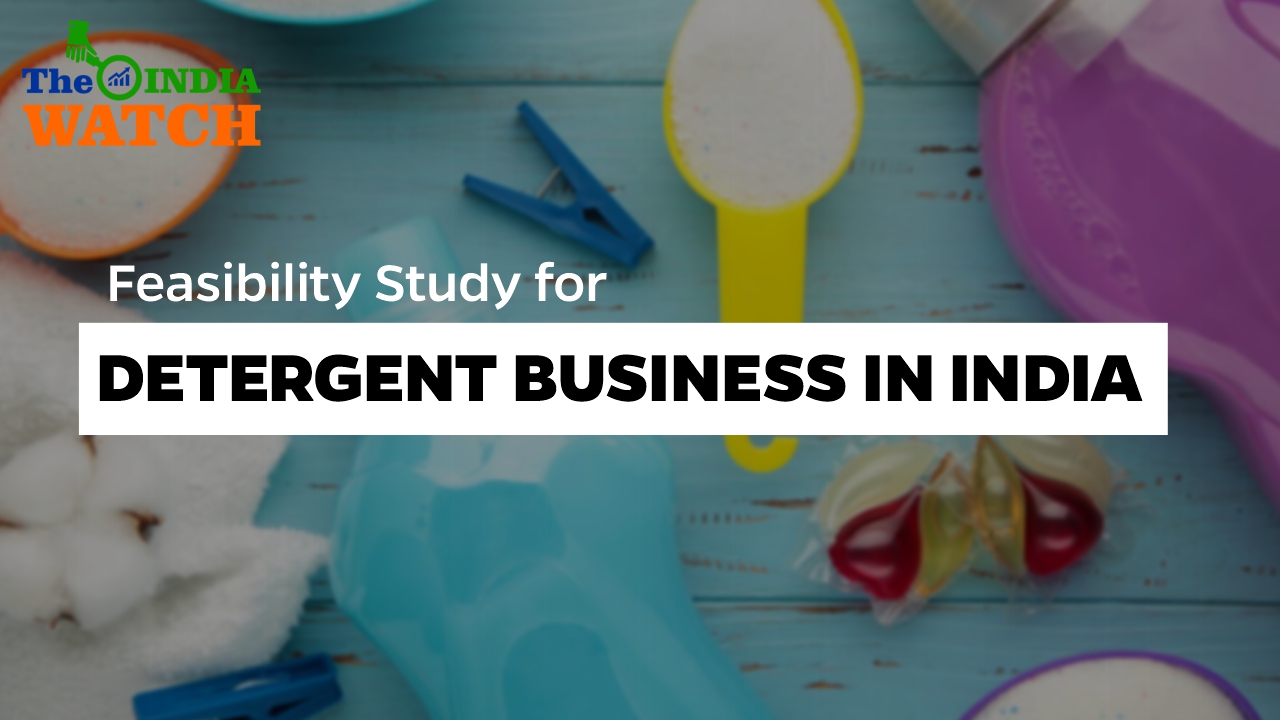-
Your trusted market research partner
- info@theindiawatch.com
- 8076704267

Project Feasibility Study for Detergent Business in India

The Indian detergent market will continue to grow as consumerism in India keeps on evolving. In FY 23, the total production of detergent is estimated at 1.86 million tons, as per the analysis by The India Watch. The market is led by enterprises such as HUL, P&G, Godrej Consumer Products, Nirma, RSPL, etc. 60% of the market is run by organized players while the remaining is managed by local small-scale entities.
Price wise the detergents can be split into 3 types— premium products (Ariel, Surf), mid-ranged ( Rin, Henkel, Tide), and budget products (Ghari, Nirma, local products, etc.). Usages wise the Indian market is divided into 3 types such as detergent bars, hand detergents (including both liquid and powder), and machine-based detergents. North is the largest consumer of detergents (30%) followed by West and South (25% each).
Factors driving growth in Indian Detergent Market
There are multiple factors that are driving the growth of the detergent market in India
- India’s large population, the surge in middle-income households, and evolving consumerism are some of the fundamental factors that drive demand for detergents and other personal care products.
- The Rural consumption patterns are also transforming in the country backed by growth in the rural economy and a rise in appetite for FMCG products. The fast penetration of internet in the rural India is also playing a pivotal role in increasing awareness. Research in the past has suggested that rural households spend 3-5% of their monthly income on soaps, detergents, etc.
- The pandemic has been instrumental in raising awareness of personal care and hygiene. This is also driving demand for detergents alongside other categories such as personal care, soaps & lotions, handwash, etc.
- India’s overall growth and spurt in the organization in retail are conducive to the rise in detergent demand. As the number of hypermarkets, supermarkets, malls, grocery stores, local community shops, etc. are rising, detergents are becoming very easily available.
- The rise in e-commerce has also drastically boosted the accessibility and availability of detergents, especially among middle-income households in India.
- Detergent companies are also coming up with new products and packages to match the growing consumer patterns in the country. From 200 gm sachets to 2 kg packs, a wide range of product packages are available these days.
- The role of detergent is evolving and is not just limited to stain remover. Increasingly the definition of detergent now includes other functions as well such as fragrant imparter, conditioning of clothes, softening of fabrics, etc.
- To further build on the growing demand, along with regular marketing, Indian brands are spending heavily on promotions in the form of digital advertisements, viral videos, free samples, social media, etc.
The Growing Chemical Detergent Intermediate Market in India

As the detergent market in India is growing, there is also a rising appetite for chemical intermediates used in the industry such as caustic soda, soda ash, sulphonic acid, hydrated lime, zeolite, etc. In FY 22, the total production of detergent chemical intermediate reached 780,000 tons, growing at 5.97% on a yearly basis. From FY 17 to 22, the total market has grown at a CAGR of 3.8%.
Although there has been a surge in domestic production, the market still relies on imports. In FY 22, 273,000 Metric tons of intermediate has been imported. From FY 17 to 22, the import of chemical intermediates increased at a CAGR of 3.7%.
The substantial rise in imports of chemical intermediates also indicates that there is plenty of potentials to develop indigenous manufacturing. Already India is the 3rd largest consumer and 6th biggest producer of chemicals globally. The sector holds a high priority in the government agenda. GOI has formulated a host of plans including but not limited to 100% FDI, SEZs, and PLI to support the chemical sector in the country.
How the India Watch can help with Project Feasibility Study
India is fertile ground for the soaps and detergent industry. While existing players will expand to tap into the rising demand, there is also ample space for new players to emerge and consolidate their position at local, state-level, and zonal levels.
If you are a business or investor who is planning to venture into the space but is not clear on how to start, probably a project feasibility study will be an apt idea. Not only it will give a Go or No—Go decision but will also enable businesses to get a lot of actionable insights on the market, growth drivers, demand, value chain, etc.
A well-prepared project feasibility study can offer a wide range of actionable insights:
- Market size, growth statistics of the market, future size of the market, category-wise market share, etc.
- Consumer assessment, consumer demand analysis, consumer trend analysis, need & want analysis, the evolution of consumption, etc.
- Consumer profiling and segmentation based on age group, income, social profile, ethnicity, occupation, etc.
- Market opportunity scanning.
- Competitive insights- key players, market share, product information, growth strategy, market positioning, pricing strategy, promotion strategy, etc.
- Information on retail distribution, pricing, margins, and split b/w online and offline. etc.
- Information on supply chains, machinery, equipment vendors, etc.
- Strategic growth plan to capture a larger market share.
- Insights on market promotion – online, offline, public relationships, etc.
- Human resource planning
- Financial analysis- projected revenue, profitability analysis, ratio analysis, etc.
If you are looking for the project feasibility study for a detergent (or another related category such as personal care, cosmetics, body wash, etc.) then feel free to connect with us at info@theindiawatch.com
